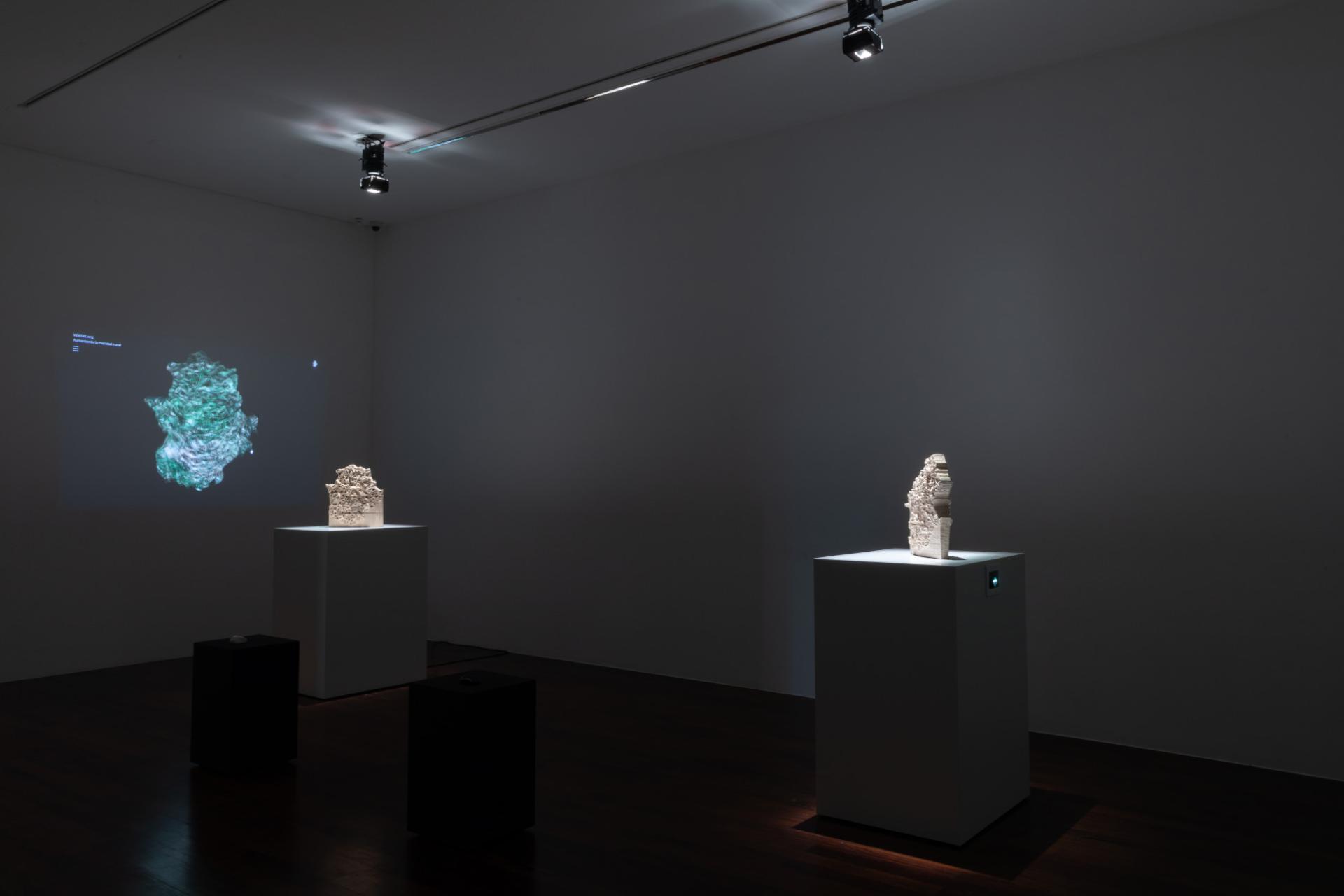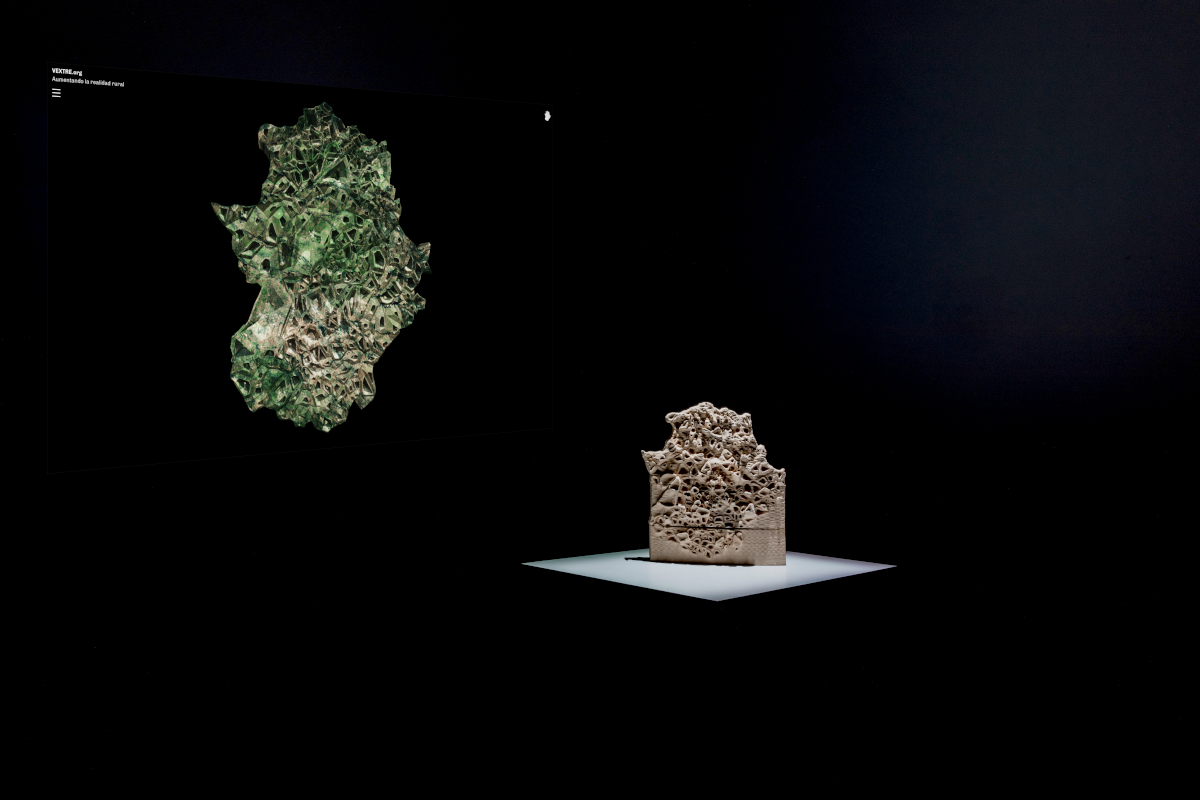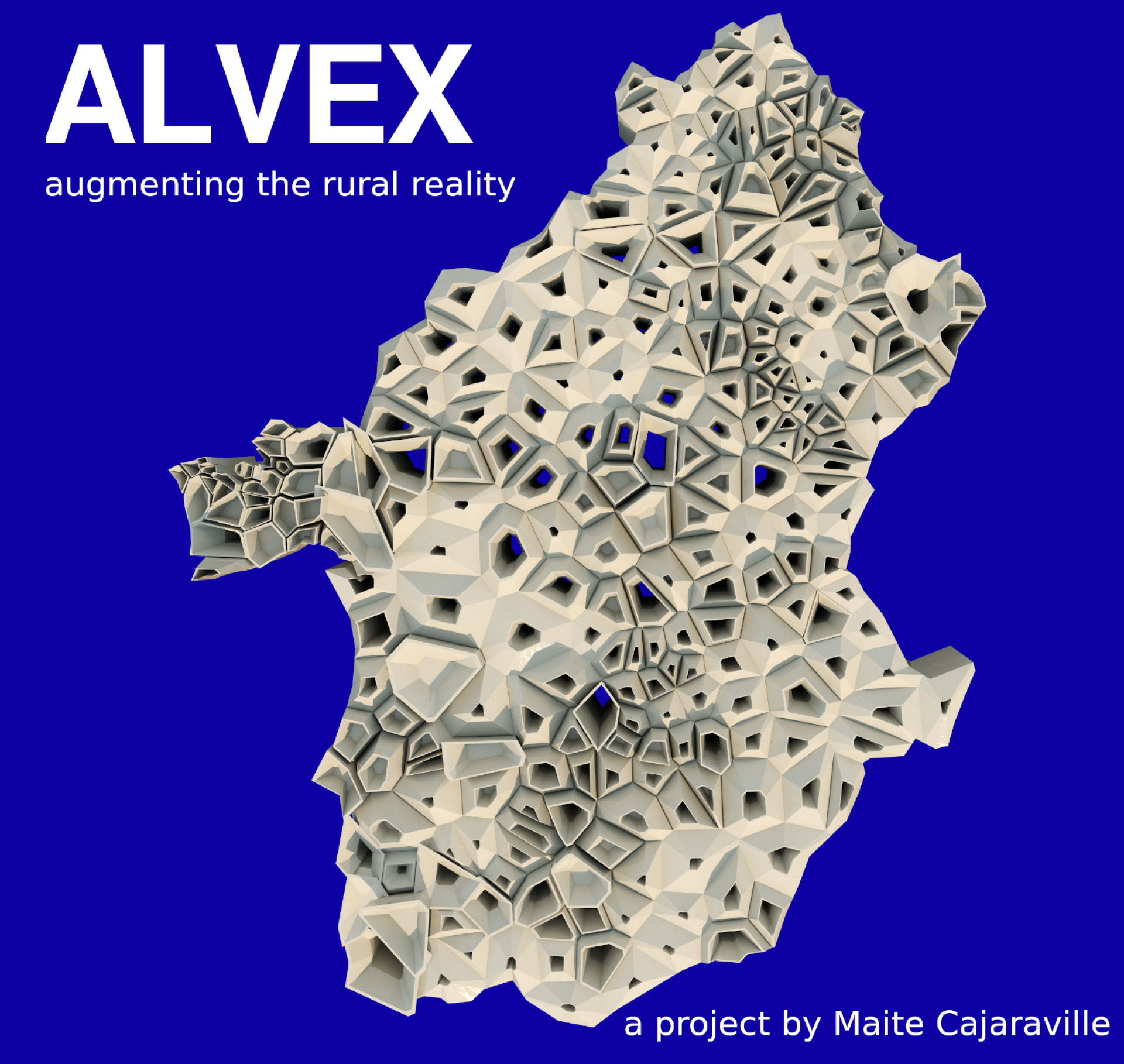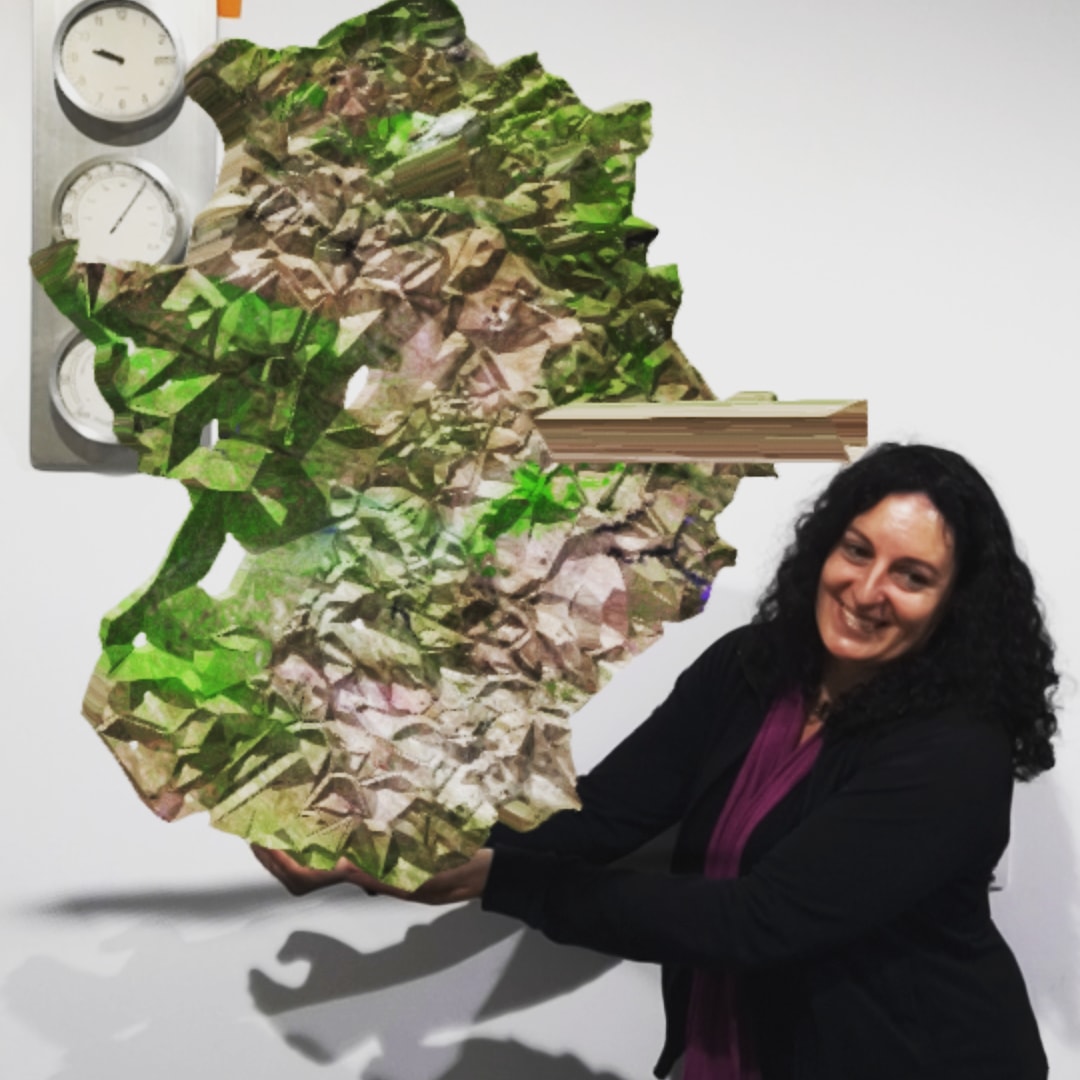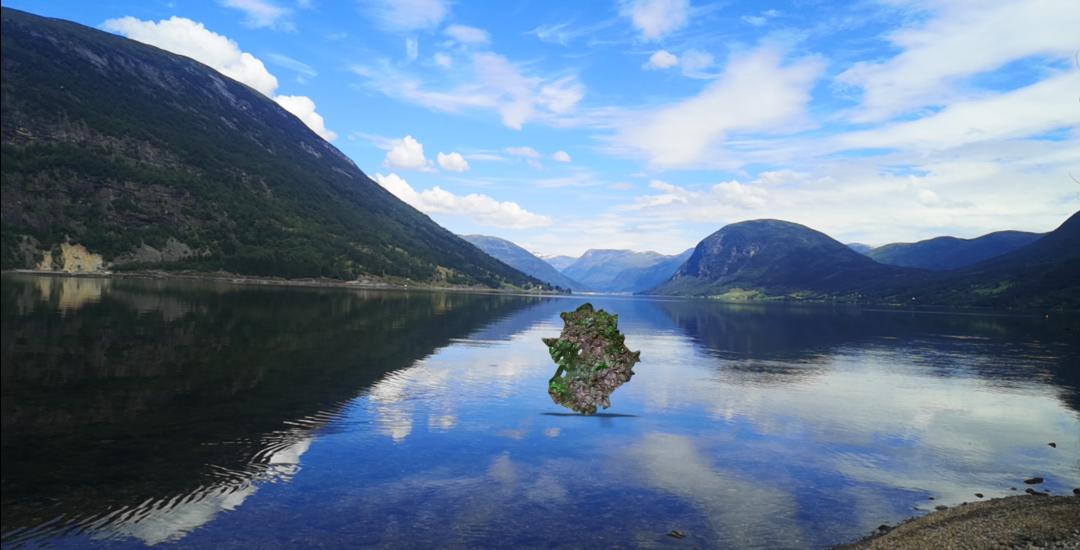VEXTRE, Augmenting Rural Reality
Basic information
Project Title
Full project title
Category
Project Description
VEXTRE is an interoperable data based electronic art project by Maite Cajaraville, From an exhaustive investigation of socio-economic datasets of the municipalities of a rural region, she generates physical and virtual three-dimensional sculptures of the territories, shaped by data and municipalities locations. VEXTRE encourages the co-design of a new rural identity by incorporating citizen digital tools and community mediators to engage people in a conversation about rural culture.
Geographical Scope
Project Region
Urban or rural issues
Physical or other transformations
EU Programme or fund
Which funds
Description of the project
Summary
Maite Cajaraville, Spanish pioneer on new media art, was born in an emptied European region, Extremadura. Adding her personal approach to her social vision, she started this innovative data based electronic art project in 2017, aimed to draw attention to rural communities and to the consequences of the new extractivism, the lack of personal and professional opportunities and the loss of sense of belonging and cultural identity.
From an exhaustive investigation of a variety of socio-economic data of the municipalities of a rural region, she generates physical and virtual three-dimensional sculptures of the territories. A 3D printer is used to create the physical ceramic piece, while the virtual one is presented in augmented reality.
The 3D sculptures are shaped by data and municipalities locations. The increases in their orography represent positive coefficients such as having access to education, good health services, a public transport network and a number of locally owned businesses, while the depressions show negative factors such as depopulation or a sharp gender gap.
The project adopted the name VEXTRE in April 2021, following a solo exhibition at the Museum of Contemporary Art of Extremadura. VEXTRE underlines the rural conditioning factors, but also shows how new ruralities embrace sustainability on green territories of talent, culture, care and collaboration.
The innovative use of data and technology results in sculptures of enormous beauty and a remarkable organic strength that can be perceived as emotional maps of rural life.
Aware of its educational and political potential, VEXTRE encourages the co-design of a new rural identity by incorporating citizen digital tools and community mediators to engage people in a conversation about rural culture and future, taking sustainable development goals as a compass.
VEXTRE’s interoperability has already allowed the translation of its free technologies based modus operandi to the Portuguese region of Alentejo.
Key objectives for sustainability
As a pioneering artistic project, VEXTRE undertakes several challenges in terms of sustainability.
VEXTRE ensures its sustainable growth over the time. Its interoperability allows the project to instance itself along the EU rural communities, empowering rural areas to work together for a fairer society and a more sustainable lifestyle.
It uses free technologies and Creative Commons licensing. The 3D ceramic printer manufacturing and processes, the datasets and the methodology are published in the digital realm. This way, the project advances a path and gives a wink at the development of more local, sustainable, inclusive and innovative industries, as well as a model of creative based entrepreneurship.
As for social return on investment, VEXTRE encourages co-design and facilitates a dialogue among rural communities through digital tools and cultural mediators. To date, there have been more than 20 activities around the project that can be seen as a call to action to reduce inequalities and prejudices, awakening rural communities with a message about the urgency of taking care of natural resources to preserve the next generation’s future.
Besides, VEXTRE’s sculptures are printed in ceramic, a traditional non-polluting material that connects art with environmental sustainability.
The project also examples the optimization of resources as a way of shortening processes by working with the same team and improving its methodology over the time, so the audience gets a better aesthetic experience and the community gets more advanced technological knowledge each time, describing a virtuous circle of socio-economic sustainability.
Finally, the deployment of new instances of this interoperable project is also energetically sustainable in terms of transportation, as all the necessary, including a large 3D printer and a team of four people, can travel in a medium-sized van.
Key objectives for aesthetics and quality
Aesthetics is inherent to VEXTRE by its artistic condition, but it goes beyond, as it has been built on fostering and showing the beauty that emerges from data.
Data visualization reaches a beautiful, functional and innovative dimension through VEXTRE’s pieces. Natalia Piñuel, curator of the instances to date, Extremadura (Spain) and Alentejo (Portugal), has called them "sculptures of the future". José Alberto Ferreira, co-curator of the Portuguese exhibition, named them “oracles”, underlining the powerful atmosphere that those ceramic pieces cause in the audience, an almost magical environment that the company of the virtual extensions does not break, but even intensifies, bringing people an impactive experience.
As cryptic as the oracles of bygone times, the sculptures speak of each region’s raw materials, its demographic profile and its economic constraints, presenting the territory in an eloquent three-dimensional form. They show large amounts of information at first glance but then attract people to get closer to the details, both aesthetic and informative, that the volumes and textures of their highs and lows convey. Since these ups and downs represent the well-being and discomfort of the municipalities in the region under study, it can be said that both the ethics and the aesthetics of data make the sculptures an example of rare beauty.
As with an oracle, it is not the answers that matter, but rather what we do with them. From the outset, the opportunity the visitor is presented with for doing away with stereotypes and preconceived ideas about the territory is remarkably functional and effective in political terms.
In addition, the combination of ceramics and augmented reality creates a landscape where rural communities meet technology. Crafts merge with the most advanced art, drawing the union of raw materials and virtual elements and highlighting the inherent beauty of the coexistence of tech and nature when one is used to preserve the other.
Key objectives for inclusion
VEXTRE itself aims to be a starting point to achieve the inclusion of rural territories and to overcome the rural-urban dichotomy as a factor of inequality that sharps the gap between wealth and poverty and the unequal access to quality education.
A series of narratives that facilitate dialogue and drive the audience to share a collective exercise of critical thinking emerge through the pieces. The audience's reflection is also promoted on social media, re-published and cheered/followed by the digital mediators. Each individual feels that his or her opinion has the same value as the others do, generating a space of respect, empathy and a feeling of belonging. The data flows by using the same pathways that define cultural transmission, through affective, community, social and educational processes, thus building identity.
At the same time, the project reformulates internalized prejudices about rural territories by linking them with a technological and advanced image that interferes with traditional patterns of backwardness. This happens not just as part of its electronic art condition. VEXTRE also proposes a hybrid augmented reality display that interacts with the community through any mobile device. Each piece has its own website and a specific augmented reality filter, also available through Instagram. This set enables people to visualize the socio-economic data, experience for themselves the visual capabilities of augmented reality and include the virtual piece in their photos, encouraging reflection on the territory and rekindling a sense of belonging by allowing them to walk their region around the world or place it in their most everyday spaces or with their loved ones. By breaking the museums’ limits, Cajaraville advances other possible formats for art exhibitions that go beyond the classic white cube.
VEXTRE provides the community with artworks that everyone can take on their mobile phones, bringing art closer even to citizens living in remote rural areas.
Results in relation to category
We’ve already mapped Extremadura’s rural reality by developing two instances of this Spanish region, one with data from the period 2014-2017 and the other from 2018-2021, significantly improving the interface between one and the other, both aesthetically and in terms of functionality and accessibility.
Applying all these improvements, we’ve mapped the Portuguese Alentejo this year. It is important to highlight that the mapping of the most depopulated region of Portugal wasn’t scheduled in the initial collaboration agreement among the artist, MEIAC Museum and the Eugénio de Almeida Foundation, but its artistic director felt challenged by the possibilities of social conversation about shown by VEXTRE in Extremadura and decided to expand the terms.
Regaining a sense of belonging in each of the regions is the core of this collaboration, but it is also remarkable that the mapping of Alentejo’s rural reality has not just propelled the project towards internationalization.
We’ve developed more than 10 workshops to date, all taken place in rural communities in the last 6 months. The team has worked with various audiences: kids, teenagers and youngsters; rural cultural mediators; journalists, industrial designers and telecommunications engineers and rural women associations, among others.
In autumn 2021, the project obtained a grant from the Spanish Ministry of Culture and Sports, which allowed to initiate a series of communicative actions as the creation of https://info.vextre.org, the launch of various press releases, the writing of a growing amount of narrative materials in three languages (Spanish, English and Portuguese) and the community management of our Instagram, Facebook and Twitter accounts.
In addition, we’ve increased the dialogue with international artists and curators, making visible the reality of rural communities and disseminating the message that culture and art are perfect vehicles for the recovery of the sense of belonging.
How Citizens benefit
VEXTRE is an open, collaborative tool aimed at promoting critical processes with a proactive spirit for citizens, with special emphasis on transferring knowledge to the territory involved in each instance.
In coherence with the purpose linking contemporaneity and new technologies to rural territories and their communities, the filters available on the URL of the instances developed to date, as well as in VEXTRE’s Instagram account (@vextre_extremadura) appear as the common thread that allows citizens to co-design the project through their photos.
However, as in any complex project, the creation of a network of dynamic agents in social innovation is required to “motivate” citizen participation. This network allows mapping a minimum number of interventions and images published on social networks with VEXTRE’s augmented reality displays to achieve a critical mass of participation.
In addition to enriching the project and raising its results through the progressive incorporation of these dynamic agents, stable alliances have been established with local organizations closely linked to the population. As a paradigmatic example, it is possible to underline a collaboration agreement that has been established with the network of Popular Universities of Extremadura (AUPEX), which is structured in two sets of actions –cultural and technological– in rural territories, all free of charge for the people and groups involved or interested.
The artist has also developed workshops in collaboration with the Science and Technology Park of Extremadura, intended to university and doctoral students, as well as with Ras de Terra, and a traditional tobacco dryer recovered as a space for artistic residencies.
Physical or other transformations
Innovative character
VEXTRE is innovating in various forms, from the way it has been created to the goals it is achieving on each step.
The project started five years ago as an innovative approach from the field of electronic art to rural communities with focus on social change and reflection, as to enhance critical thinking.
VEXTRE also addressed a rural audience, facilitating the access to art and culture from their mobile devices, breaking the geographical barriers to cultural content.
VEXTRE is also innovative as a consequence of the freedom it promotes, not imposing to see an artwork, but to interact with it, creating a collaborative model of co-creation and even co-innovation.
VEXTRE has also embraced a transversal political position based on SDO’s as the values of citizenship and humanity, contrapossed to particular ideological positions.
As for the new media art field, the project transforms data in a ceramic sculpture, from abstraction to materiality, Data as a new kind of aesthetics. The results itself challenges the prejudiced values associated with ruralities, presenting the rural through a very innovative and technological artistic perspective. .
One of VEXTRE’s main goals is its interoperability. Acting initially as a prototype, the project can become a rural flag to EU territories.
Besides, the variety of digital tools created to access the project: website, social media, Instagram filters, all at once, generated an innovative engine of engaging people to interact on the digital global conversation about new ruralities.
The inclusion of the citizens on the shape of the project, promoting their engagement in a conversation about belonging and cultural identity through artworks, cultural mediators and the translation of written materials to several languages, not only English, but Spanish and Portuguese. Digital tools to enhance belonging.
Finally, VEXTRE also creates a dialogue about the traditional materials and new media.
Learning transferred to other parties
VEXTRE wants to become the artistic flag of beauty, sustainability and inclusion of the rural areas of the European Union, mapping those areas and promoting a conversation not just to empower each of their communities to build a new and joyful sense of belonging, but to build also a common sense of belonging shared by all the European Union rural communities.
This interoperable artistic and community project that has recently closed a stage, first looking at the Spanish region where the artist was born, and then developing the same creative process on a Portuguese region, although improved in its entirety. Both regions are predominantly rural, emptied and low-income, and also share hundreds of kilometers of common border.
Instantiation in other rural communities across Europe is now the main part of the project's natural evolution. VEXTRE proves to be a "case study" because its architecture can be extrapolated to other rural regions simply by changing the datasets. The technological process needed to create similar pieces elsewhere is already developed, thus accelerating the future production of new instances.
From a social point of view, the problems faced by rural communities in the European Union have many points in common, as do the tools and resources used by the project to promote the recovery of the sense of belonging and the fostering of cultural identity. This idea facilitates its instantiation in any European region but is perfectly compatible with carefully taking into account the peculiarities of each rural territory, its environment, cultural heritage and inhabitants.
VEXTRE proves to be a "case study" because its architecture can be extrapolated to other rural regions simply by changing the datasets. The technological process needed to create similar pieces elsewhere is already developed, thus accelerating the future production of new instances.

